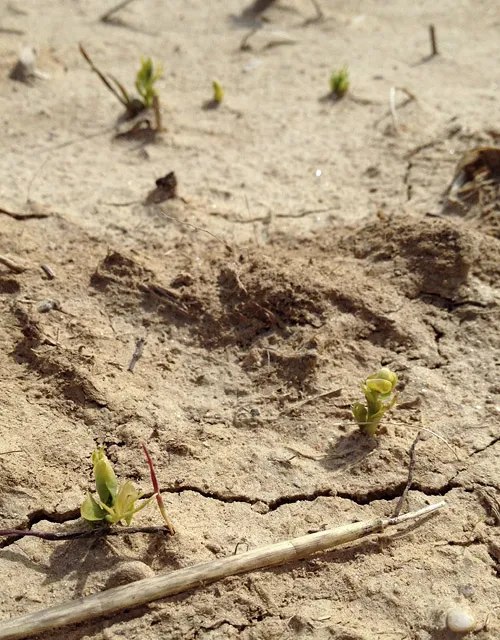Sunday Farmer
Last Sunday I made my March trip out to the farm. I restrict these trips, costly as they are in time and gas dollars, and I would go more often if it were, say, outside my back door. This trip was necessary because there was work to be done, it was a beautiful day and the farm can be restorative.
My first task, a task that could have been accomplished on my last visit were I ready for the work, was to hoe a 6 x 120 foot row between the beds. This is a utility path and I have no desire to keep it bare soil. I was dreading the physical labor, but my new soil rake made short work of it -I finished in 20 minutes!
Afterward, I inspected the rows more closely. The Saffron Crocus, Crocus sativus, appears to be doing quite well despite its already sprouting, two months late planting. There will be locally grown saffron come autumn.
If you are a regular reader, it's no surprise to hear from me that wind is one of the biggest challenges to growing near the ocean. The evidence laid bare on my rows, the prevailing winter wind's direction is marked on the soil by northwest to southeast striations.
But! What's this pale emergence? None other than December's very late planted cover crop on my other 60 percent. With luck this cover should be vigorous and dark green before June. Then we'll till it under to plant summer's cover.
My last visit, during the bluster of February, revealed much freeze burn on the eagerly growing Turban strains, but they are beginning to look better. Above is Thai Purple, with a good amount of raw heat, an early harvest and one of the earliest cured garlic strains to market.
Here we have Burgundy, one of three Creole strains I am growing this season. I'm expecting much from this strain -attractive crimson skins, sweet, and a very long shelf life, nearly as long as the Silver Skin strains.
Alfalfa meal has become this season's source for nitrogen and organic matter, both of which are lacking in my field. The cost of shipping blood meal and goose-eaten corn gluten meal had me resist both of these nitrogen-rich fertilizers. I need four times as much alfalfa meal as the two others (3 % vs. 12% available nitrogen), but Agway ordered it for me at $22 per 50lb sack and no shipping costs, which combined made it competitive with blood meal, with the added benefit of alfalfa's organic matter.
Alfalfa meal is dusty, like most fertilizers, so you want to wear a mask if you're pouring a lot. All fertilizers have peculiar odors, but this one smells like a clean horse stall, which in my book ain't all that bad. The down side to alfalfa meal is the increase in quantity needing to be spread. There'll be four times as much spreading as corn or blood.
Something about the alfalfa brought out the bees.
I made several passes over each row until I used 150 pounds on the entire plot. Given the wind and other concerns, I couldn't just leave the meal sitting on top of the soil. Tedious, yes, but I passed over each row of garlic with a leaf rake to stir up the soil and provide lodging for blown fertilizer. I also timed the spreading to be just before the coming rain, which came the next morning and not long after the wind had died down.
I have another 150 pounds to spread before early May, considerably more difficult as the leaves will be much taller than the axle of my spreader. I don't like scraping the soil with the rake either. This must be given more thought for next season. In fact, I have a gallon of kelp and another of fish to spread with a pump sprayer and that may be the best way to go during the active growing season.
Preparing to leave, I headed to the van, blindly walking into a cloud of midges. You do know that nothing says spring like a swarm of mating midges, don't you?















Comments
Post a Comment
Go ahead and comment! I will moderate and delete the spam. Thx